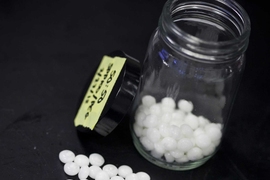MIT researchers have developed a compact, portable pharmaceutical manufacturing system that can be reconfigured to produce a variety of drugs on demand.
Just as an emergency generator supplies electricity to handle a power outage, this system could be rapidly deployed to produce drugs needed to handle an unexpected disease outbreak, or to prevent a drug shortage caused by a manufacturing plant shutdown, the researchers say.
“Think of this as the emergency backup for pharmaceutical manufacturing,” says Allan Myerson, an MIT professor of the practice in the Department of Chemical Engineering. “The purpose is not to replace traditional manufacturing; it’s to provide an alternative for these special situations.”
Such a system could also be used to produce small quantities of drugs needed for clinical trials or to treat rare diseases, says Klavs Jensen, the Warren K. Lewis Professor of Chemical Engineering at MIT.
“The goal of this project was to build a small-scale, portable unit that was completely integrated, so you could imagine being able to ship it anywhere. And as long as you had the right chemicals, you could make pharmaceuticals,” Jensen says.
Jensen, Myerson, and Timothy Jamison, the head of MIT’s Department of Chemistry, are the senior authors of a paper describing the new system in the March 31 online edition of Science. The lead author is MIT research associate Andrea Adamo.
More flexibility
Traditional drug manufacturing, also known as “batch processing,” can take weeks or months. Active pharmaceutical ingredients are synthesized in chemical manufacturing plants and then shipped to other sites to be converted into a form that can be given to patients, such as tablets, drug solutions, or suspensions. This system offers little flexibility to respond to surges in demand and is susceptible to severe disruption if one of the plants has to shut down.
Many pharmaceutical companies are now looking into developing an alternative approach known as flow processing — a continuous process that is done all in one location. Five years ago, an MIT team that included Jamison, Jensen, and Myerson demonstrated a larger prototype (24 by 8 by 8 feet) for the continuous integrated manufacturing of drugs from chemical synthesis to tablets. That project has ended, but the continuous manufacturing initiative, funded by Novartis, is still underway as the researchers develop new methods for synthesis, purification, and formulation.
In the new endeavor, funded by the Defense Advanced Research Projects Agency (DARPA), the MIT researchers built on what they learned from the Novartis-funded project to create a much smaller, transportable device. Their new system can produce four drugs formulated as solutions or suspensions — Benadryl, lidocaine, Valium, and Prozac. Using this apparatus, the researchers can manufacture about 1,000 doses of a given drug in 24 hours.
Key to the continuous system is the development of chemical reactions that can take place as the reactants flow through relatively small tubes as opposed to the huge vats in which most pharmaceutical reactions now take place. Traditional batch processing is limited by the difficulty of cooling these vats, but the flow system allows reactions that produce a great deal of heat to be run safely.
“In many cases we were developing syntheses of targets that had never been done in a continuous flow platform,” Jamison says. “That presents a lot of challenges even if there is a good precedent from the batch perspective. We also recognized it as an opportunity where, because of some of the phenomena that one can leverage in [a flow-based system], you can make molecules differently.”
The chemical reactions required to synthesize each drug take place in the first of two modules. The reactions were designed so that they can take place at temperatures up to 250 degrees Celsius and pressures up to 17 atmospheres.
By swapping in different module components, the researchers can easily reconfigure the system to produce different drugs. “Within a few hours we could change from one compound to the other,” Jensen says.
In the second module, the crude drug solution is purified by crystallization, filtered, and dried to remove solvent, then dissolved or suspended in water as the final dosage form. The researchers also incorporated an ultrasound monitoring system that ensures the formulated drug solution is at the correct concentration.
Small-scale manufacturing
John Lewin, the division director of critical care and surgery pharmacy at Johns Hopkins Hospital, says this type of manufacturing could bring down production costs and help patients get better access to the drugs they need.
“This sets the foundation for a new paradigm in terms of the way we manufacture pharmaceuticals and distribute them to patients,” says Lewin, who was not involved in the study. “Such a device could really meet a lot of the supply chain challenges here in the U.S. and around the world.”
One of the advantages of this small-scale system is that it could be used to make small amounts of drugs that would be prohibitively expensive to make in a large-scale plant. This would be useful for so-called “orphan drugs” — drugs needed by a small number of patients. “Sometimes it’s very difficult to get those drugs, because economically it makes no sense to have a huge production operation for those,” Jensen says.
It could also be useful in regions with few pharmaceutical storage facilities, because drugs can be produced on demand, eliminating the need for long-term storage.
“The idea here is you make what you need, and you make a simple dosage form, because they’re going to be taken on demand. The dosages don’t have to have long-term stability,” Myerson says. “People line up, you make it, and they take it.”
The researchers are now working on the second phase of the project, which includes making the system about 40 percent smaller and producing drugs whose chemical syntheses are more complex. They are also working on producing tablets, which are more complicated to manufacture than liquid drugs.











